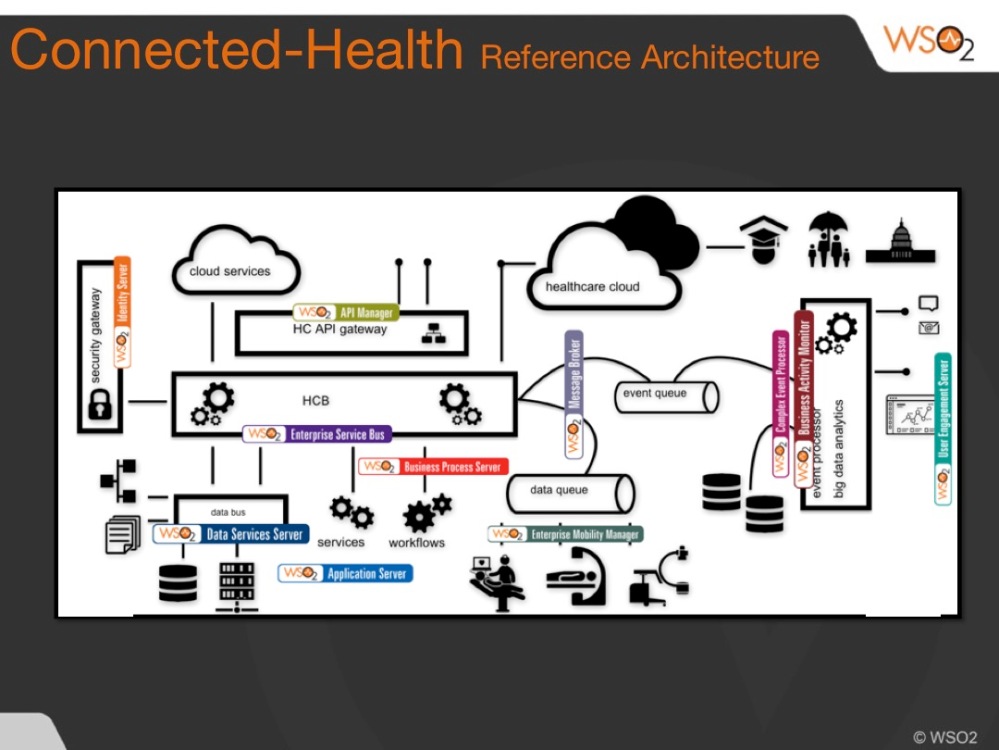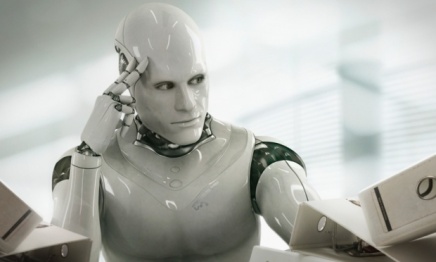Change is happening in our health care system in the US. There are a number of factors both endogenous to the health care industry and external to it converging to create a real chance for significant change. Evidence for that change are numerous including a biotech boom, genetics boom, information systems boom. More money is being spent on healthcare systems and technology for the first time in a long time. WSO2 is seeing a significant amount of its revenue coming from health care companies.
Some of the endogenous change includes:
Better understanding and ability to manipulate genes.
The ability to manipulate genes has progressed at a fantastic rate reminiscent of the rate of computer hardware change, literally billions of times faster than before and cheaper. The first genome sequencing took years but it is now possible for $100 to sequence your genetic code in a few days, determine your ancestry and your health proclivities.
Clinical trials are being done with various flavors of genetic manipulation. One trial is testing pancreatic cells that can produce insulin in precise reaction to a body’s needs like a person’s own body would. This would be a cure for Type 1 Diabetes, a disease that afflicts more than a million people in the US alone. Type 2 diabetes may not be far behind and afflicts 29 million people in the US alone. For years we’ve been promised cures for cancer and the problem is we really had no idea fundamentally what cancer was precisely let alone a way to stop it.
The ability to see and manipulate what is happening at the atom level
is uncovering fundamental new understanding of how drugs work, don’t work and what kind of drug is needed to get something done. Learning how to target specific cells by seeing precisely atomic level markers. Our ability to see and manipulate at the nano level has also crossed a barrier of utility that now makes many things possible that weren’t before.
An example of this is a new drug by Genentech that will literally stop the common cold. Genentech identified a precise marker on all cold viruses and constructed an antigen that precisely attacks it without your body’s immune system. This is incredibly important as many people die with a defective immune system unable to fight the common cold.
This is just some of the change happening inside the biology business that portend over the next few decades truly astounding impacts.
Other factors related to data, computers and the social aspect of medicine sometimes called Connected Health ( what I call Platform 3) is enabling a new kind of medical care and medical data that everyone is hoping will finally transform our medical system into a more personal, more efficient and intelligent system.
Connected Health
Connected health is about connecting the patient, the patient data, the providers, the researchers, the payers into a cohesive system that enables radical change in quality of service and knowledge of disease itself.
Connected Devices
The ability to have connected devices (Internet of Things) such as medical monitoring devices on an outpatient basis can impact clinical studies costs as well as length of time in hospitals. It can help patients get response to problems faster and it can help create a much closer connection of provider and patient.
These devices are hoped to enable less time in hospitals reducing health care costs and also more responsive and consistent care in or out of the hospital. More outpatient services. It also can mean faster reaction to medical conditions, warnings of potential conditions. Google is working as are some other companies on devices that can detect the symptoms of heart attack or stroke before it happens. Some people think of IOT for health is all about fitness trackers. That is just the surface of what is happening.
Bigdata in Healthcare
Medical information consists of Medical records (EHR), Medical History (past actions and events, prescriptions), Genomic information, Clinical Data, IOT data and mobile collected data. These last categories are newer but form a lot of the backbone of what people hope will tie together all the data to make sense of things at a level never before possible
One has to understand that our ability today to find out what any one thing does to a disease or to your body is confounded by the vast differences that comprises each person. The different things that different people eat, the different combination of other conditions they have, genetic predispositions, the different behaviors and routines of people are so different that it becomes almost impossible to control for all these variables and conclude anything without enormous expense. Even then the data is sparse and things go wrong. A company does a study on a drug and after over a hundred million dollars in studies discovers years later that it causes impacts that render the drug more of a problem than a benefit. More information, more bigdata, more careful and precise monitoring of patient data through the use of connected technologies enables a way to drastically reduce the cost of studies and simultaneously massively increase the amount of information available to discern what is really going on.
The ability to collect vast amounts of data about patients in electronic records and combine that with data from millions of people and their experiences in daily routine can drastically impact our understanding of how disease is onset, how to manage disease, what works and doesn’t work, and a potentially powerful way to gain new ideas about the intersection of drugs, supplements and behavior. This can change the cost of trials by orders of magnitude by leveraging big data to find correlations that are impossible to discern with limited clinical trials we do today.
Similarly the ability to analyze vast amounts of genetic data and studies combined with health data can produce vast new insight and creativity in what possible drugs, supplements or behaviors can impact our health.
Apple is helping organize some of this effort in an initiative called HealthKit. However, the energy and ideas driving all this come from a vast array of optimistic individuals who believe that with the connected technologies we can dramatically change, reduce the cost and improve the results of medical care.
HIPAA and progress
The last couple decades saw a tremendous effort to insure the privacy of medical information for patients. Ironically the next several decades may see the reversal of some of that. The ability to leverage connected health care comes to some extent from the ability to merge the experiences and results of millions of patients. If patients believe the health data will be reasonably anonymized and will be used to benefit them then I believe millions will agree to share their medical information and their behavior data for the good of humankind. However, if that information is abused or the results aren’t forthcoming we may see a backlash. I am optimistic that having vast amounts of data will help us uncover information that will be of incredible value to the health of everyone. I am very hopeful that people will not abuse this information. (Crossing my fingers)
What is Connected Health?
Connected healthcare connects all aspects of a patient and his providers as well as the information the patient needs to make decisions and understand his condition. It is estimated that a typical hospital (not sure what that is) will have to maintain 1,000 Terabytes of patient information in a few years.
1) Connect the patient with his care giver to be able to get answers and options
2) Connect the patient with his insurance sources to get information on his options
3) Bringing together electronically all information on a patient from genomic data to data from IOT devices and mobile devices as well as all the patients Electronic health records and history.
4) The ability of the patient to control and expose their information for the betterment of themselves and others
5) The ability of the patient to socialize with others who have a similar situation
6) The ability of the patient to leave the hospital when possible using IOT monitoring devices or to receive outpatient care using IOT devices and to automate data collection and make it portable wherever the patient is
7) An open environment for new technology to leverage medical information in an anonymized way
The Future of Healthcare
What we are going to see is a combination of a much more precise and learned industry able to figure out how to attack specific problems, with tools to engineer solutions like never before and with data to understand impact and bring to market cheaper and faster new therapies and lessons, drugs, treatments, behaviors that will change the face of medical care dramatically over the next 10 to 20 years.
The medical industry in the US is over $3 trillion. The scale of it is almost impossible to imagine. Across the world health care averages 10% of GDP, in the US twice that. In the US there are millions of providers. Getting change across such a vast and huge empire of companies and competing interests has been an incredible challenge over the years.
It is estimated to cost $38 billion just to change to the ICD10 coding system. A coding change costs more than the GDP of some countries. It’s ridiculous. The sheer number of participants and scale makes change on a large scale prohibitively difficult, time consuming and expensive. The politics surrounding health care are intimidating as everyone is affected and it is deeply politicized at times. All these factors conspire to make one pessimistic about the possibility of change.
Lack of information inhibits change. Even if someone discovers something that is better the ability to propagate that throughout such a vast system is inhibited by the disconnectedness of the system. Vast sections of the industry can remain blithely ignorant and unresponsive because nobody knows there is a better way. Connectedness promises a flood of information that counteracts the inertia of this system. Everyday hundreds of millions of people will have access to information that they can confront the elements that resist what benefits them. Consumers will see choices. They will demand and change will come faster than we have seen before. Information will drive change.










One thought on “The virtuous circle Connected Health will drive Healthcare improvements faster”